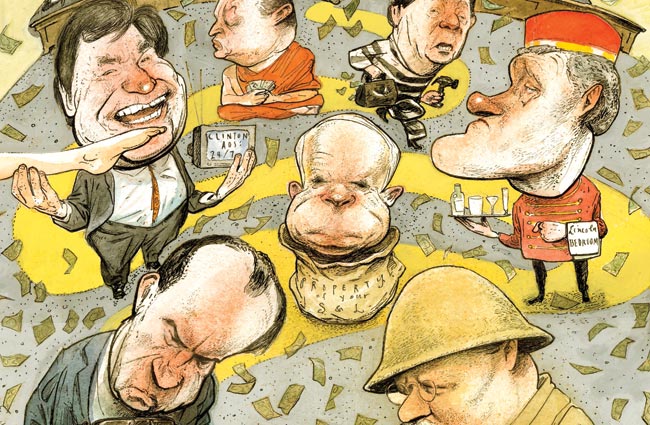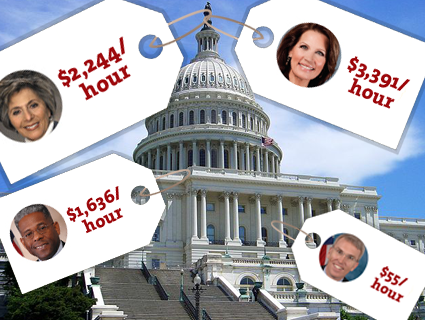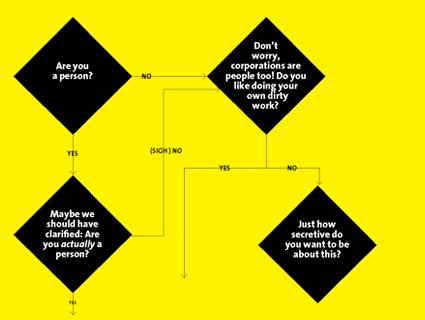WHY WE BUILT THIS
Tracking the flow and impact of money in politics has long been one of Mother Jones‘ main beats. Since the 2010 Citizens United decision paved the way for a new era of bottomless election spending, we’ve been focused on what we call “dark money”—the hundreds of millions of dollars being dropped by outside groups, much of it without full disclosure of where it’s coming from.
The key players in this new world are super-PACs, which may raise and spend unlimited sums of money for or against candidates; and 501(c) nonprofit groups, which may make political ads and give money to super-PACs without disclosing their donors.
We wanted to visualize the major super-PACs and 501(c)s in a way that would provide both a good overview of outside spending in this election cycle as well as detailed information about each group. The universe metaphor was in keeping with the idea of dark money, and provided an eye-catching way to show how groups share orbits (i.e., super-PACs linked directly to nonprofits) and constellations of similar organizations (e.g., labor unions and pro-business groups). And just as in outer space, not everything is visible to the naked eye, as signaled by the fuzzy edges on the 501(c) groups.
The current version of this chart shows just one slice of the dark-money universe: There are hundreds of smaller super-PACs and 501(c)s that are not included in this version. Over the months leading up to Election Day, we’d like to expand this universe to include more groups. We’d also like to include links to profiles of groups and their top donors, present more information on which candidates each group is spending for and against, and add an animated timeline showing super-PACs’ growth over time.
Keep coming back—the data is live and so is this news app.
METHODOLOGY
The first version of this chart appeared in the January/February 2012 issue of Mother Jones. The groups included were identified by looking at the lists of the biggest super-PACs and 501(c)s by revenue and spending on the Center for Responsive Politics’ invaluable OpenSecrets.org. We chose a selection of groups that had raised the most money, spent the most money in 2010, or were worth including due to their interestingness, links to other outside-spending groups, or their potential impact in 2012. This list has been edited and expanded for this interactive version.
Each group’s size is proportional to its most recently reported revenues. For super-PACs, this is based on total fundraising receipts in the 2011-12 election cycle. For 501(c)s, this is based on annual revenue reported on each group’s most recent tax forms.
Regularly updated data on super-PACs’ finances is filed with the Federal Election Commission. Our news app accesses this data by way of an API provided by the New York Times, which includes information on each super-PAC’s donors and spending. Original research on each group was stored in a Google Doc; we then used the Google Spreadsheets API to join this information with data from the Times API. All of this data is outputted to a JSON file which is then visualized using the D3 Javascript charting library. We request new data from the NYT API and refresh the visualization once a week.
Data on 501(c) groups can be spotty or outdated, since they do not have to publicly disclose their donors or all of their political spending. Though publicly available, their tax forms may be more than a year old or unavailable if the group is less than a year old. We have downloaded their most recent IRS 990 forms via the National Center for Charitable Statistics.
Tools used
D3, a Javascript charting library for data-driven visualization, modeling, and much more
Coffeescript for making Javascript hurt less
New York Times Campaign Finance API for retrieving super-PAC funding and donor data
Google Spreadsheets API for retrieval of research generated in-house and stored in a Google Spreadsheet
Gdata Python Client for making Python and Google Spreadsheets play nice together
Human-assisted reporting for parsing and fact-checking super-PAC data, collecting 501(c) data, and additional research on groups
Anchor Steam Summer Beer for making everything hurt less











